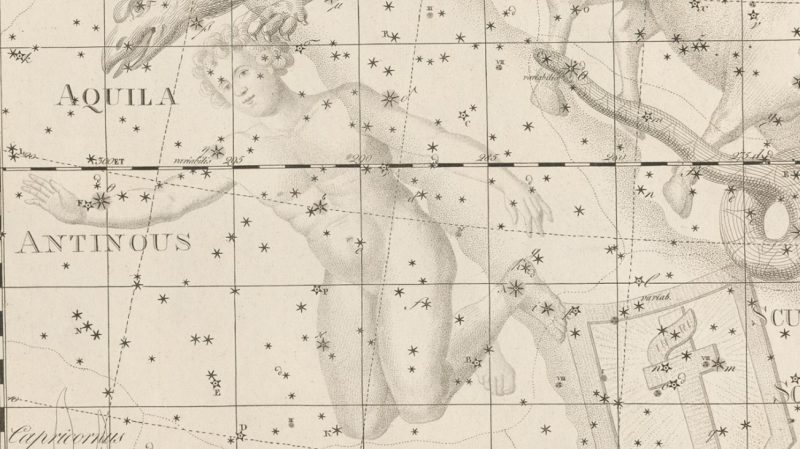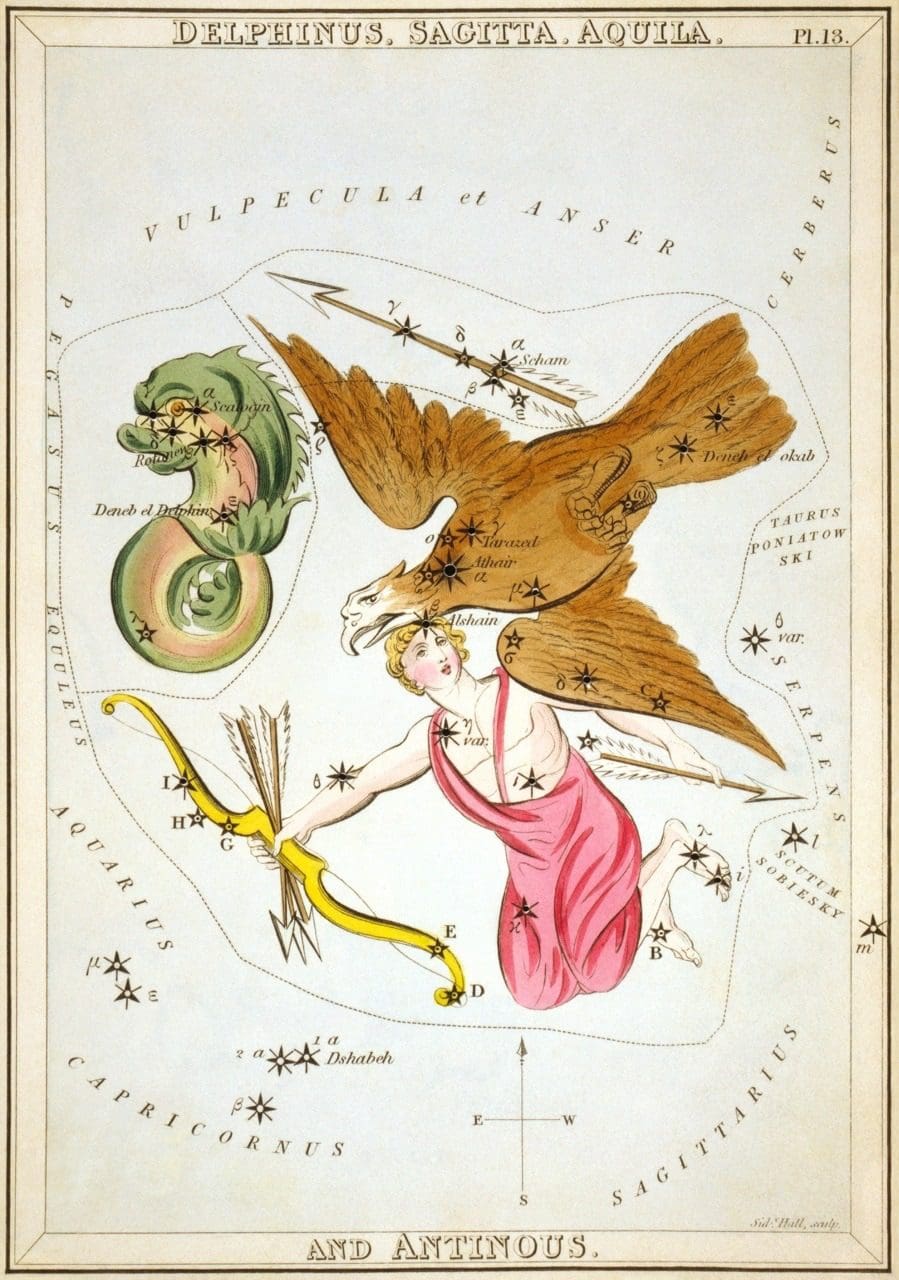FIXED STARS: Major Stars | 1000+ Stars | Constellations | About
The obsolete constellation Antinous is a northern constellation bordering Aquila, Serpens, Scutum and Sagittarius.Antinous was created by the emperor Hadrian in 132, and its stars now belong to Aquila. It spans 27 degrees of the zodiac in the Signs of Capricorn and Aquarius.
Abbreviation: Ani
Genitive: Antinoi [1]
Antinous Constellation Stars
| 2000 | 2050 | Star | Name | Sp. Class | Mag. | Orb |
|---|---|---|---|---|---|---|
| 17♑20 | 18♑02 | λ Aql | Al Thalimain Prior | B9 | 3.43 | 1°40′ |
| 23♑25 | 24♑08 | ν Aql | F2 | 4.64 | 1°00′ | |
| 23♑38 | 24♑20 | δ Aql | Almizan I | F0 | 3.36 | 1°40′ |
| 24♑51 | 25♑33 | κ Aql | B0 | 4.93 | 1°00′ | |
| 25♑50 | 26♑32 | ι Aql | Al Thalimain Posterior | B5 | 4.36 | 1°10′ |
| 27♑48 | 28♑30 | σ Aql | B3 | 5.18 | 1°00′ | |
| 00♒25 | 01♒08 | η Aql | Almizan II | F6 | 3.87 | 1°30′ |
| 04♒55 | 05♒37 | θ Aql | Antinous | B9 | 3.24 | 1°50′ |
Antinous Astrology
Robson
ANTINOÜS.
History. Antinoüs was a youth of extraordinary beauty, born in Bithynia, and was the favorite of the Emperor Hadrian. He is said to have drowned himself in the Nile in the belief that the Emperor’s life would thereby be prolonged, and the constellation was formed in his honor by Hadrian in 132 A.D. Antinoüs has also been associated with Ganymedes who was seized by an eagle and carried off to be cupbearer to Jupiter, but this legend belongs more probably to Aquarius.
Influence. No astrological influence was suggested for this constellation by the ancients, but it seems to have been associated with the ideas of passion, love and friendship, for certain of its components stars were named Alkhalimain or Al Halilain, the Two Friends, by the Arabs, and the Kabalists associated it with the Hebrew letter Vau and the 6th Tarot Trump “The Lovers.” It has also been said to give a love of swimming, and to be connected to certain sex irregularities, the latter probably being greatest in that part of the constellation lying in Capricorn.
Note. Antinoüs lies just south of Altair in Aquila and is now taken as part of this constellation. He is sometimes represented as carrying a bow and arrow as he is borne aloft in the Eagle’s talons. [2]
Allen
Antinoüs lies in the Milky Way, directly south from the star Altair; the head of the figure at η and σ, the rest of the outline being marked by θ, ι, κ, λ, ν and δ, all now in Aquila. Flamsteed omitted σ and ν from his catalogue, but added i.
The constellation is said to have been introduced into the sky, in the year 132, by the Emperor Hadrian, in honor of his young Bithynian favorite, whose soul his courtiers had shown him shining in its lucida after the youth’s self-sacrifice by drowning in the Nile from his belief that his master’s life might thus be prolonged. This was because the oracle at Beza had asserted that only by the death of the object which the emperor most loved could great danger to the latter be averted. The new asterism, however, was little known among early astronomers; and although Ptolemy alluded to it, he did so but slightingly in calling half a dozen of the ἀμόρφωτοι of Aquila ἐφ᾽º ὦν ὁ ἀντίνοος.
After his day it seems unnoticed till Mercator put it on his celestial globe of 1551 with six components; Bayer following him in illustrating it with Aquila, although with no distinct list of its stars. Tycho also utilized it; but it first separately appeared in print on a plate in Kepler’s Stella Nova of 1606, and in his Rudolphine Tables. Longomontanus (Christian Longberg of Denmark) had it in his Astronomica Danica of 1640; Hevelius included it in the Prodromus, but added a Bow and Arrow, the ancient Sagitta; Flamsteed mentioned it in the Historia Coelestis as Aquila Antinous, Aquila vel Antinous, and Aquila cum Antinoo; and the Hungarian Jesuit Abbé Maximilian Hell had it in constant use in his Ephemerides Astronomicae of 1769 and 1770. Bode also distinctly catalogued and illustrated it; but Argelander omitted its title from his Uranometria Nova of 1843, although he showed it as a part of Aquila. It is now hardly recognized, its stars being included with those of the latter constellation.
Bayer substituted Ganymedes for Antinoüs, and others have used both names indiscriminately.
This same name occasionally has appeared for Aquarius, but is given by La Lande, with many other titles, for our Antinoüs; among these are Puer Adrianaeus, Bithynicus, Phrygius, and Troicus; Novus Aegypti Deus; Puer Aquilae; Pincerna and Pocillator, the Cup-bearer.
Two of the Arabic globes bear the stars δ, θ, κ and λ Aquilae, which mark the distinguishing rhombus of Antinoüs, as Al Ṭhalīmain, the Two Ostriches; but Ideler assigned this title to ι and λ; giving δ, η, and θ as Al Mizān, the Scale-beam. Simone Assemani said that they were Alkhalimain, that more correctly is Al Ḣalīlain, the Two Friends, or Al Ḣalimatain, the Two Papillae; but his assertions as to star-names are often unfavorably criticized by Ideler as “a confused medley, raked together without criticism.” [3]
References
- SkyEye: Antinous
- Fixed Stars and Constellations in Astrology, Vivian E. Robson, 1923, p.27.
- Star Names: Their Lore and Meaning, Richard H. Allen, 1889, p.40-42.

